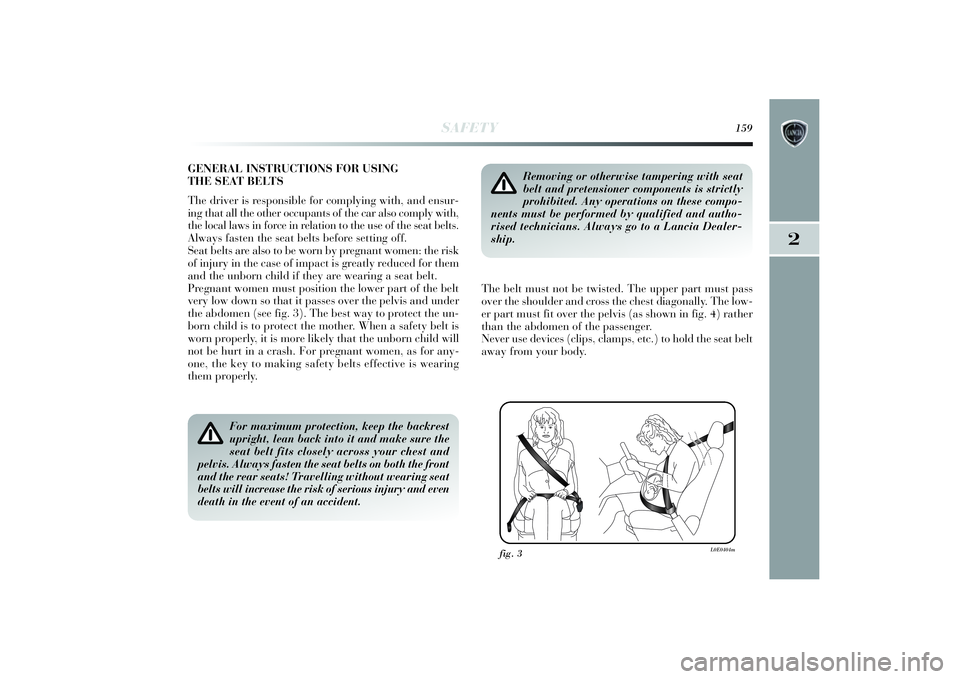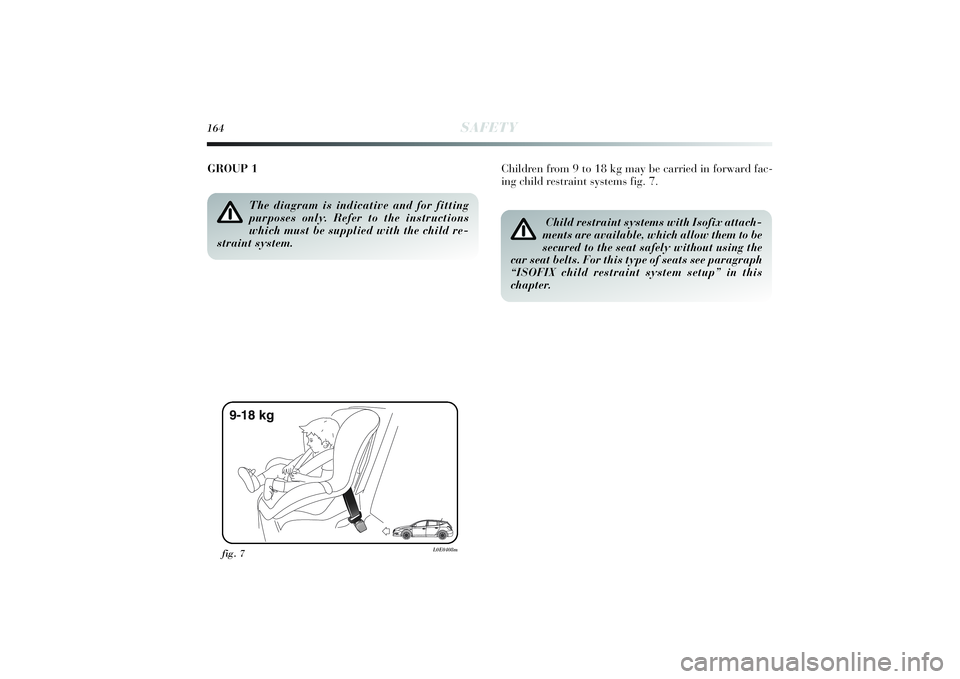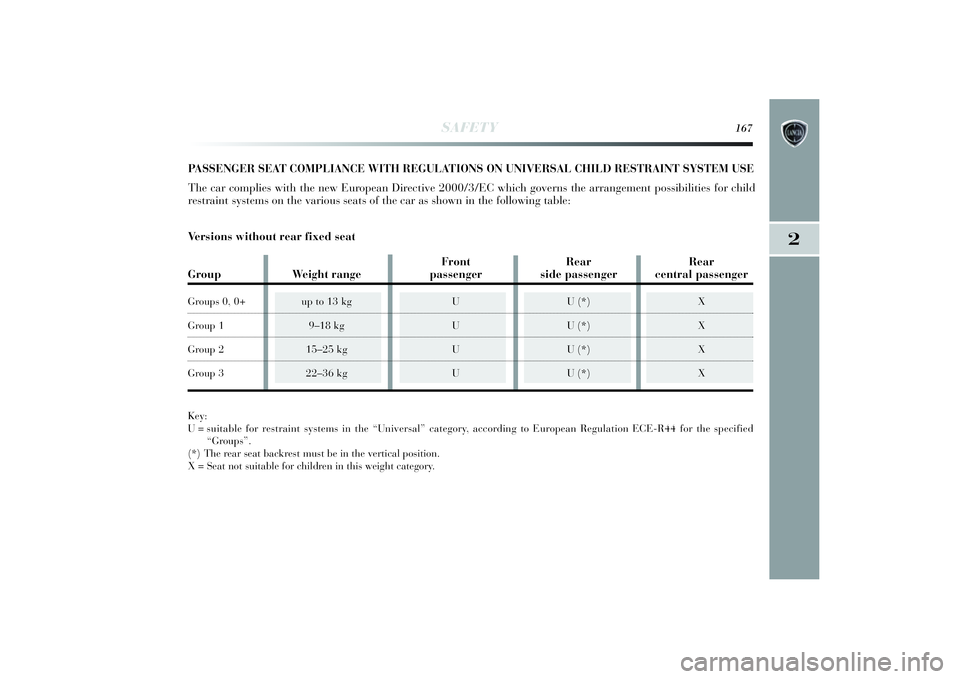Lancia Delta 2014 Owner handbook (in English)
Manufacturer: LANCIA, Model Year: 2014, Model line: Delta, Model: Lancia Delta 2014Pages: 291, PDF Size: 5.24 MB
Page 161 of 291

SAFETY
159
2
GENERAL INSTRUCTIONS FOR USING
THE SEAT BELTS
The driver is responsible for complying with, and ensur-
ing that all the other occupants of the car also comply with,
the local laws in force in relation to the use of the seat belts.
Always fasten the seat belts before setting off.
Seat belts are also to be worn by pregnant women: the risk
of injury in the case of impact is greatly reduced for them
and the unborn child if they are wearing a seat belt.
Pregnant women must position the lower part of the belt
very low down so that it passes over the pelvis and under
the abdomen (see fig. 3). The best way to protect the un-
born child is to protect the mother. When a safety belt is
worn properly, it is more likely that the unborn child will
not be hurt in a crash. For pregnant women, as for any-
one, the key to making safety belts effective
is wearing
them properly.
For maximum protection, keep the backrest
upright, lean back into it and make sure the
seat belt fits closely across your chest and
pelvis. Always fasten the seat belts on both the front
and the rear seats! Travelling without wearing seat
belts will increase the risk of serious injury and even
death in the event of an accident.
fig. 3
L0E0404m
The belt must not be twisted. The upper part must pass
over the shoulder and cross the chest diagonally. The low-
er part must fit over the pelvis (as shown in fig. 4) rather
than the abdomen of the passenger.
Never use devices (clips, clamps, etc.) to hold the seat belt
away from your body.
Removing or otherwise tampering with seat
belt and pretensioner components is strictly
prohibited. Any operations on these compo-
nents must be performed by qualified and autho-
rised technicians. Always go to a Lancia Dealer-
ship.
155-182 Delta GB 1ed 26/08/13 11.29 Pagina 159
Page 162 of 291

160
SAFETY
If the belt has been subjected to a high level
of stress, for example after an accident, it
must be completely replaced together with the
attachments, attachment fixing screws and the pre-
tensioner. In fact, even if the belt has no visible de-
fects, it could have lost its resilience.
SEAT BELT MAINTENANCE
For keeping the seat belts in efficient conditions, observe
the following:
❍always make sure the belt is well stretched and never
twisted; make sure that it is free to run without ob-
structions;
❍check seat belt operation as follows: attach the seat belt
and pull it hard;
❍replace the belt after an accident of a certain severity
even if it does not appear to be damaged. Always re-
place the seat belt if the pretensioners were deployed;
❍to clean seat belts, wash by hand with water and mild
soap, rinse and leave to dry in the shade. Never use
strong detergents, bleach, paints or any other substance
which could damage the belt fibres; Each seat belt must be used by only one person. Never
travel with a child sitti
ng on the passenger’s lap using the
seat belts to protect them both, fig. 5.
Do not fasten any other object to the body.
fig. 4
L0E0403m
fig. 5
L0E0405m
155-182 Delta GB 1ed 26/08/13 11.29 Pagina 160
Page 163 of 291

SAFETY
161
2
❍prevent the retractors from getting wet: their correct
operation is only guaranteed if water does not get in-
side;
❍replace the seat belt when it shows significant wear
or cuts.
❍replace the seat belt when it demonstrates significant
wear or cuts.
CARRYING CHILDREN SAFELYFor optimal protection in the event of an impact, all oc-
cupants must be seated and wearing adequate restraint
systems, including newborn and other children!
This prescription is compulsory in all EC countries ac-
cording to EC Directive 2003/20/EC. Compared with an
adult, a child’s head is larger and heavier in proportion
to his/her body and the child’s muscular and bone struc-
tures are not fully developed. Therefore, correct restraint
systems other than adult seat belts are necessary to reduce
as much as possible the risk of injuries in the event of an
accident, braking or a sudden manoeuvre.
Children must be seated safely and comfortably. As far
as the characteristics of the chi
ld restraint systems used
allow, you are advised to keep children in rear facing re-
straint systems for as long as possible (at least until 2 years
old), since this is the most protected position in the event
of an impact. The choice of the most suitable child re-
straint device depends on the weight of the child; there are
various types of child restraint systems and you are ad-
vised always to choose the one that is most suitable for the
child.
When over 1.50 m in height, from the point of view of
restraint systems, children are considered as adults and
wear seat belts normally.
155-182 Delta GB 1ed 26/08/13 11.29 Pagina 161
Page 164 of 291

162
SAFETY
Should it be necessary to carry a child on the
passenger side front seat in a rear facing
child restraint system, the passenger side
front airbag and side bag (for versions/markets,
where provided) must be deactivated through the
Setup menu. Deactivation should be verified by
checking whether the warning light is switched on
in the instrument panel. Move the passenger’s seat
as far back as possible to avoid contact between the
child restraint system and the dashboard.Do not move the front or rear seat if a child
is seated on it or on the dedicated child re-
straint system.On the sun visor there is a label with suitable
symbols to remind you that it is compulsory to
deactivate the airbag if a rear facing child re-
straint system is fitted. Always comply with the in-
structions on the passenger’s side sun visor (see the
“Front Airbags” paragraph).
In Europe the characteristics of children restraint systems
are ruled by the regulation ECE-R44, dividing them into
five weight groups:Group Weight rangeGroup 0 up to 10 kgGroup 0+ up to 13 kgGroup 1 9-18 kgGroup 2 15-25 kgGroup 3 22-36 kg
All restraint devices must bear the type-approval data
along with the control mark on a fixed label which must
never be removed in any circumstances. Lineaccessori
Lancia includes child restraint systems for each weight
group. These devices are recommended, having been
specifically designed for Lancia cars.
155-182 Delta GB 1ed 26/08/13 11.29 Pagina 162
Page 165 of 291

SAFETY
163
2
FITTING THE “UNIVERSAL” CHILD
RESTRAINT SYSTEM
(with seat belts)
GROUP 0 and 0+ Children up to 13 kg must be carried with rear-facing
restraint system of a type as shown in fig. 4 which, sup-
porting the head, does not induce stress on the neck in the
event of sudden decelerations.
The restraint system is restrained by the car seat belts as
shown in fig. 6 and it must restrain the child in turn with
its own belts.
The diagram is indicative and for fitting
purposes only. Refer to the instructions
which must be supplied with the child re-
straint system.
fig. 6
L0E0407m
155-182 Delta GB 1ed 26/08/13 11.29 Pagina 163
Page 166 of 291

164
SAFETY
Children from 9 to 18 kg may be carried in forward fac-
ing child restraint systems fig. 7. GROUP 1
The diagram is indicative and for fitting
purposes only. Refer to the instructions
which must be supplied with the child re-
straint system.
Child restraint systems with Isofix attach-
ments are available, which allow them to be
secured to the seat safely without using the
car seat belts. For this type of seats see paragraph
“ISOFIX child restraint system setup” in this
chapter.
fig. 7
L0E0408m
155-182 Delta GB 1ed 26/08/13 11.29 Pagina 164
Page 167 of 291

SAFETY
165
2
GROUP 2
Children from 15 to 25 kg may use the car seat belts di-
rectly, fig. 8.In this case, the child restraint system is used only to po-
sition the child correctly with respect to the seat belts so
that the diagonal belt section crosses the child’s chest and
not the neck, and the lower part is snug on the pelvis,
not the abdomen.
The diagram is indicative and for fitting
purposes only. Refer to the instructions
which must be supplied with the child re-
straint system.
fig. 8
L0E0409m
155-182 Delta GB 1ed 26/08/13 11.29 Pagina 165
Page 168 of 291

166
SAFETY
GROUP 3 For children between 22 kg and 36 kg, there are dedicated
restraint systems that allow the seat belt to be worn cor-
rectly.
Figure 9 shows correct child seat positioning on the rear
seat. Children over 1.50 m in height can wear seat belts
like adults.
The diagram is indicative and for fitting
purposes only. Refer to the instructions
which must be supplied with the child re-
straint system.
fig. 9
L0E0410m
155-182 Delta GB 1ed 26/08/13 11.29 Pagina 166
Page 169 of 291

SAFETY
167
2
PASSENGER SEAT COMPLIANCE WITH REGULATIONS ON UNIVERSAL CHILD RESTRAINT SYSTEM USEThe car complies with the new European Directive 2000/3/EC which governs the arrangement possibilities for child
restraint systems on the various seats of the car as shown in the following table:Key:
U = suitable for restraint systems in the “Universal” category, according to European Regulation ECE-R44 for the specified
“Groups”.
(*) The rear seat backrest must be in the vertical position.
X = Seat not suitable for children in this weight category.
Front Rear Rear
Group Weight range passenger side passenger central passengerGroups 0, 0+ up to 13 kg U U (*)XGroup 1 9–18 kg U U (*)XGroup 2 15–25 kg U U (*)XGroup 3 22–36 kg U U (*)XVe r sions without rear fixed seat
155-182 Delta GB 1ed 26/08/13 11.29 Pagina 167
Page 170 of 291

168
SAFETY
Ve r sions with rear fixed seatKey:
U = suitable for restraint systems in the “Universal” category, according to European Regulation ECE-R44 for the specified
“Groups”.
X = Seat not suitable for children in this weight category.
Rear Rear
Front side passenger Rear side passenger
Group Weight range passenger (passenger side) central passenger (driver side)Groups 0, 0+ up to 13 kg U U U XGroup 1 9–18 kg U U U XGroup 2 15–25 kg U U U XGroup 3 22–36 kg U U U X
155-182 Delta GB 1ed 26/08/13 11.29 Pagina 168